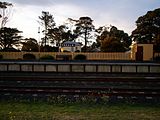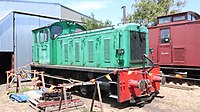Bellarine Railway
38°15′42″S 144°39′35″E / 38.261772°S 144.659729°E
| Bellarine Railway | |
|---|---|
 | |
| Overview | |
| Status | Active |
| Stations | Drysdale, Lakers Siding and Queenscliff |
| Website | bellarinerailway |
| Service | |
| Type | Tourist |
| History | |
| Opened | 1879 |
| Closed | 1976 |
| Reopened | 1979 |
| Technical | |
| Line length | 16 km (10 mi) |
| Number of tracks | 1 |
| Track gauge | 1,067 mm (3 ft 6 in) |
The Bellarine Railway, formerly the Bellarine Peninsula Railway, is a volunteer-operated steam-driven tourist railway located in Victoria, Australia. It operates on a 16 km section of a formerly disused branch line on the Bellarine Peninsula between the coastal town of Queenscliff and Drysdale, near Geelong.
History as a working railway[edit]
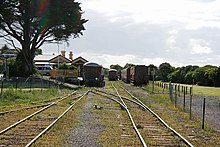
The original line was commissioned in September 1878, and opened on 21 May 1879. It connected Queenscliff with South Geelong station, the terminus of the Geelong line, and the junction of the Warrnambool line. It was acknowledged at the time that although passenger traffic alone might not justify a railway line, military traffic from both the port and Fort Queenscliff—a key defence installation—would warrant its construction. It initially carried passenger, goods and military traffic, and continued to do so for several decades.
In the first few months of operation, it carried only one service per day, but at its peak, in January 1885, four trains per day ran in each direction, enabling the line to be used by commuters. However, this was decreased to three, and was cut back to two trains a day in 1910. Traffic on the line continued to fall over the next twenty years, and in 1931, passenger services were dropped completely—apart from the occasional Sunday excursion train. Freight services continued to run, although they were cut to back at first to twice-weekly, and then weekly operation.
The line saw a revival during World War II, carrying mines from the Swan Island military base, but returned to pre-war levels afterwards. After the war, services became less frequent, with passenger services dropped altogether, apart from occasional special trains, and with goods services cut back to one a fortnight. The line was closed on 6 November 1976. The line is recognised as the oldest Victorian branch line still in operation.[1]
Preservation and re-opening as a tourist railway[edit]
In 1968, when the Queenscliff line was still officially open, the Fyansford Cement Works Railway near Geelong was closed. The cement company donated all its steam rolling stock to preservation groups, and the Geelong division of the Australian Railway Historical Society (ARHS), which was still in its infancy, received two engines. While Drysdale station was looked upon as a preferred site, this proved difficult to arrange, and a temporary site at the Belmont Common was used.
The Geelong division of the ARHS registered itself as the Geelong Steam Preservation Society in 1970 and it constructed and operated a small tourist railway, the Belmont Common Railway, on the Belmont Common. However, the site faced ongoing problems due to adjacent developments and its location on a flood plain, and by 1976, it was apparent that continuing on the Belmont Common site would not be feasible. When it became clear that Victorian Railways intended closing the Queenscliff line, the GSPS saw an opportunity, and after the line was closed permanently in 1976, it began shifting operations to Queenscliff railway station.

During 1976 and 1977, the Society engaged in fundraising efforts and began regauging a short section of track around Queenscliff station, in order to enable its rolling stock to operate on the line. With the help of some government funding, it succeeded in operating its first services from Queenscliff to Laker's Siding in May 1979, and to Drysdale not long after.
Current operations[edit]

The railway currently operates a Heritage Train Service between Queenscliff and Drysdale, along the southern shoreline of Swan Bay and through grazing land, with an intermediate stop at Laker's Siding.
The heritage service is available on Sundays, most public holidays, as well as Tuesdays and Thursdays during the Easter, June and September school holidays. During the summer school holidays, trains run every day from Boxing Day until the end of the first week in January, then every day until the Australia Day weekend, except for Mondays and Fridays. The Heritage Service does not run on Day Out With Thomas and Queenscliff Music Festival weekends.
Carriage hire is available as part of the Heritage Service and suitable for children's parties or groups looking for the benefits of private train hire without the added cost.
Experiences, specials and events offered include:
- School holiday programs
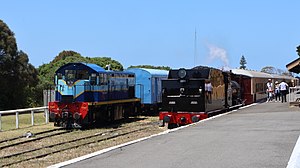
T251 gets ready to haul the 'Swan Bay Express' while 1107 sits parked in a siding with the Q train - Locomotive Cab rides available on days the Heritage Service is running
- Steam and Diesel Train Driver Experiences
- Day Out With Thomas weekends
- Special occasion and wedding charters
- Mid-week tailored group and school tours
- The Blues Train, features live music on most Saturday evenings from August to May.
The remainder of the line between Drysdale and South Geelong has fallen into disuse, and the GSPS has not attempted to extend its operations back to Leopold or South Geelong. The sections of the former route from Drysdale to South Geelong, along with a walking track adjacent to the Queenscliff-Drysdale line, now form the Bellarine Rail Trail, accessible to cyclists and walkers.
The railway features a working collection of locomotives from all four state government-run 1,067 mm (3 ft 6 in) gauge railway bodies in Australia; Tasmania, Western Australia, South Australia and Queensland; as well as from a number of Australian industrial railways. In late 2011, the railway negotiated to relocate the last remaining Australian Standard Garratt to the Bellarine Railway, from the Newport Railway Museum.[2] The transportation of the locomotive took place on 31 May 2013, with the Bellarine Railway hoping to restore it to active service.
Locomotives[edit]
Steam locomotives[edit]
| Image | Number | Type | Builder | Serial No. | Year built | Status | Notes |
|---|---|---|---|---|---|---|---|
| 6 | 0-4-2T | Hudswell Clarke, Leeds | 646 | 1903 | Stored | Originally used as a shunter at the copper smelter in Wallaroo, South Australia. Later used by Australian Portland Cement (APC) on the Fyansford Cement Works Railway until 1966. | |
| 454 | PB15 (4-6-0) |
Walkers, Maryborough, Queensland | 99 | 1909 | Out of service[3] | Used by Queensland Rail until 1969.[4] Hauled tourist trains at the Bellarine Railway for some time, awaiting overhaul. | |
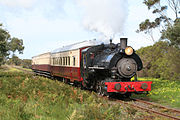
|
4 | 0-6-0ST | Vulcan Iron Works, Wilkes-Barre, Pennsylvania | 1916 | Stored | Used by APC on the Fyansford Cement Works Railway until 1966 | |
| 5 | 0-6-0ST | Vulcan Iron Works, Wilkes-Barre, Pennsylvania | 1916 | Stored dismantled | Used by APC on the Fyansford Cement Works Railway until 1966 | ||

|
T251 | SAR T (4-8-0) |
Walkers, Maryborough, Queensland | 276 | 1917 | Operational | Used by South Australian Railways until 1970. Purchased by GSPS and was in traffic on the Bellarine Peninsula Railway until 1991, when it was withdrawn due to mechanical condition. Returned to service on 11 April 2009.[5] |

|
Pozières | 0-6-0T | Andrew Barclay Sons & Company, Kilmarnock | 1543 | 1918 | Operational | Previously used by Broken Hill Associated Smelters, Port Pirie. Was on display at the Puffing Billy Railway until June 2010, when it was relocated to the Bellarine Railway. Restored to steam in 2011.[6] |
| 3620 | South African Class 24 2-8-4 | North British Locomotive Company, Glasgow | 26332 | 1949 | Operational | Owned by Ian Welch and leased to 'The Q Train', hauls The Q Train the first weekend of every month[7] | |
| Klondyke | 0-4-2T | Perry Engineering, Adelaide | 271 | 1927 | Operational | In use at Pioneer Sugar Mill in Ayr, Queensland until 1966. | |
| S547 | WAGR S (4-8-2) |
Midland Railway Workshops, Perth | 1947 | Stored Dismantled | Used by Western Australian Government Railways until 1971. Acquired by Bellarine Railway in 1980 for possible eventual restoration. | ||
| M6 | TGR M (4-6-2) |
Robert Stephenson & Hawthorns | 7429 | 1951 | Stored Dismantled | Used by Tasmanian Government Railways until 1971. Hauled tourist trains at the Bellarine Railway for some time, awaiting overhaul. | |
| V1209 | WAGR V (2-8-2) |
Robert Stephenson & Hawthorns | 7778 | 1955 | Stored | Used by Western Australian Government Railways until 1971. Brought to Victoria in 1982 by the Bellarine Railway and restored to traffic.[8] Stored pending repairs. | |
| 11 | 0-4-0T | Perry Engineering, Adelaide | 267 | 1926 | Under restoration | Originally used by the State Rivers and Water Supply Commission of Victoria in construction of the Hume Weir. Later used by APC on the Fyansford Cement Works Railway until 1966. Was on display at the Puffing Billy Railway's museum at Menzies Creek until June 2010, when it was relocated to the Bellarine Railway for eventual restoration.[9] | |
| 2 | 2-6-0+0-6-2 | Beyer, Peacock & Company, Manchester | 6935 | 1938 | Stored | Garratt locomotive used by APC on the Fyansford Cement Works Railway until 1966. Was on display at the Puffing Billy Railway's museum at Menzies Creek for some time before relocation to the Bellarine Railway for eventual restoration. | |
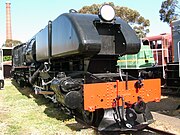
|
G33 | 4-8-2+2-8-4 | Newport Workshops | 1945 | Under Restoration | Last remaining Australian Standard Garratt, used by APC on the Fyansford Cement Works Railway until 1966. Relocated from Newport Railway Museum in May 2013, under restoration |
Diesel locomotives[edit]
| Image | Number | Type | Builder | Serial No. | Year built | Status | Notes |
|---|---|---|---|---|---|---|---|

|
V8 | 0-6-0D | Drewry Car Company | 2537 | 1955 | Operational | Operated used by AN Tasrail until 1987 |
| VA1 | 0-6-0D | Drewry Car Company | 2227 | 1947 | Under Restoration | Operated used by AN Tasrail until 1987[10] | |

|
X20 | English Electric | 1820 | 1950 | Operational | Operated used by AN Tasrail until 1987[10] | |
| X3 | English Electric | 1798 | 1950 | Operational | Operated by AN Tasrail until 1985 | ||

|
1604 | RSE92C | English Electric | A.059 | 1962 | Operational | Operated by Queensland Rail until 1991. |

|
1107 | EBR 11 class | Walkers Limited | 644 | 1971 | Operational | Hauls the Q train on non-steam operation |
| Z1 | TGR Z class | English Electric | A.249 | 1973 | Under restoration | To haul the Q Train once restored | |
| Z4 | TGR Z class | English Electric | A.252 | 1973 | Operational | Hauls the Q train on non-steam operation |
Railcars[edit]
| Image | Number | Type | Builder | Year built | Status | Notes |
|---|---|---|---|---|---|---|
| DP28 | Drewry Car Company | 1948 | Out of service[3] | Formerly used by AN Tasrail until 1978 | ||

|
DP29 | Drewry Car Company | 1948 | Out of service[3] | Formerly used by AN Tasrail until 1978 |
Restored passenger carriages[edit]
| Image | Number | Type | Builder | Year built | Withdrawn | Notes |
|---|---|---|---|---|---|---|
| ZA200 | Composite brakevan | Midland Railway of Western Australia | 1912 | 1970 (Western Australian Government Railways) | Formerly numbered ZA 9348.[11] | |
| AAR4 | A saloon/buffet carriage with a kitchen and a bar[11] | Clyde Engineering | 1937 | 1978 (AN Tasrail) | ||
| BBL10 | A saloon carriage[11] | Clyde Engineering | 1937 | 1978 (AN Tasrail) | ||
| AAR1 | A saloon carriage[11] | Clyde Engineering | 1937 | 1978 (AN Tasrail) | ||
| MMV1333 | Operated as a mail brake van | Queensland Railways | 1944 | 1988 (Queensland Rail) | Used as a dance car on the Blues Train.[11] | |
| DAV1056 | Sleeping/sitting brake van for train crew | Queensland Rail | 1924 | 1989 (Queensland Rail) | Formerly DAS1056, was operational as an open-section sleeping car, converted in 1979[11] | |
| BUV1299[11] | Evans suburban car (formerly a composite brakevan) | Queensland Rail | Unk. | Unk. (Queensland Rail) | ||
| BU465[11] | Evans suburban car | Queensland Rail | Unk. | Unk. (Queensland Rail) | ||
| BBL6 | Dog box passenger sitting car | Parsons and Gilmour | 1922 | 1972 (Tasmanian Government Railways) | Formerly ABL15, renumbered and converted into BBL6 in November 1929.[11] | |
| ABL14[11] | Dog box passenger sitting car | Parsons and Gilmour | 1922 | 1977 (Tasmanian Government Railways) | ||
| DB46[11] | Composite class brakevan | Tasmanian Government Railways | 1949 | 1987 (AN Tasrail) |
Stations[edit]
Queenscliff Railway Line | |||||||||||||||||||||||||||||||||||||||||||||||||||||||||||||||||||||||||||||||||||||||||||||||||||||||||||||||||||||||||||||||||||||||||||||||||||
|---|---|---|---|---|---|---|---|---|---|---|---|---|---|---|---|---|---|---|---|---|---|---|---|---|---|---|---|---|---|---|---|---|---|---|---|---|---|---|---|---|---|---|---|---|---|---|---|---|---|---|---|---|---|---|---|---|---|---|---|---|---|---|---|---|---|---|---|---|---|---|---|---|---|---|---|---|---|---|---|---|---|---|---|---|---|---|---|---|---|---|---|---|---|---|---|---|---|---|---|---|---|---|---|---|---|---|---|---|---|---|---|---|---|---|---|---|---|---|---|---|---|---|---|---|---|---|---|---|---|---|---|---|---|---|---|---|---|---|---|---|---|---|---|---|---|---|---|
| |||||||||||||||||||||||||||||||||||||||||||||||||||||||||||||||||||||||||||||||||||||||||||||||||||||||||||||||||||||||||||||||||||||||||||||||||||
Gallery[edit]
-
Goods Wagons at Drysdale station
-
Tasmanian Government Railways X class diesel electric locomotive as used in Tasmania, the first mainline diesel-electric locomotive purchased by an Australian government railway system
-
V class diesel shunting locomotive as used in Tasmania
-
1107 parked just outside Queenscliff Station
-
V8 parked outside of the Queenscliff Workshops
References[edit]
- ^ "About the Bellarine Railway". Bellarine Railway.
- ^ "The Electric Telegraph" (PDF). Association of Tourist Railways (Victoria). October 2011. Archived from the original (PDF) on 20 March 2012.
- ^ a b c "Locomotives". Bellarine Railway. Archived from the original on 25 May 2017. Retrieved 10 May 2017.
- ^ "Preservation Round-up". Newsrail. Vol. 1, no. 2. Vic: ARHS Victoria Division. February 1973. p. 39. ISSN 0310-7477. OCLC 19676396.
- ^ "T 251". Australian Steam. 2 October 2013.
- ^ "Pozieres". Australian Steam. 14 August 2011.
- ^ Loco’s nationwide road trip Narrow Gauge World issue 147 May 2020 page 15
- ^ "V1209 Travels East". Newsrail. Vol. 10, no. 11. Vic: ARHS Victoria Division. November 1982. pp. 256–261. ISSN 0310-7477. OCLC 19676396.
- ^ "Fyansford No.11". Australian Steam. 9 March 2011.
- ^ a b Still running… Track & Signal issue 19/3 August 2015 page 83
- ^ a b c d e f g h i j k "Our Trains". The Bellarine Railway. Retrieved 3 May 2020.
- Kenny, Paul & Kenny, Kathleen (2010). Trains,Troops & Tourists - The South Geelong Queenscliff Railway (4th ed.). Drysdale. ISBN 978-0-646-43782-8.
{{cite book}}: CS1 maint: location missing publisher (link)


